 |
|
 |
| |
Ads by Google, based on your browsing history
|
|
2020
November
28
(Extra)
|
Pleiades and even more
At the suggestion of
Giuseppe Donatiello
(who has discovered a galaxy by doing this
kind of thing),
I reprocessed
my picture of the Pleiades to greatly lighten the midtones.
Now the faint nebulae really pop out, and you can see that the nebulae nearer the
stars are bluish and those farther away are yellowish due to differences in
density of the interstellar dust.
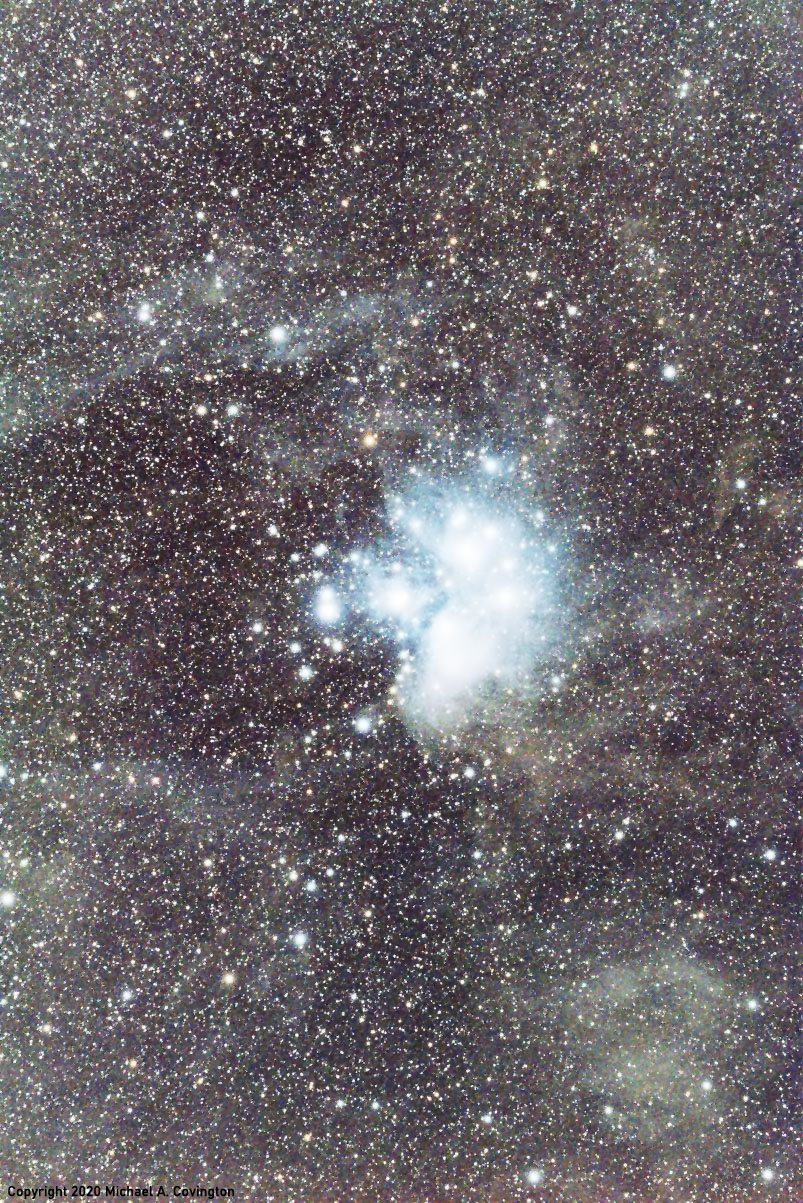
This is science, not art; the picture is less pleasing (and, at original size, was quite
grainy), but it shows you things that wouldn't otherwise be visible.
Permanent link to this entry


|
2020
November
28
|
Splendors of Orion
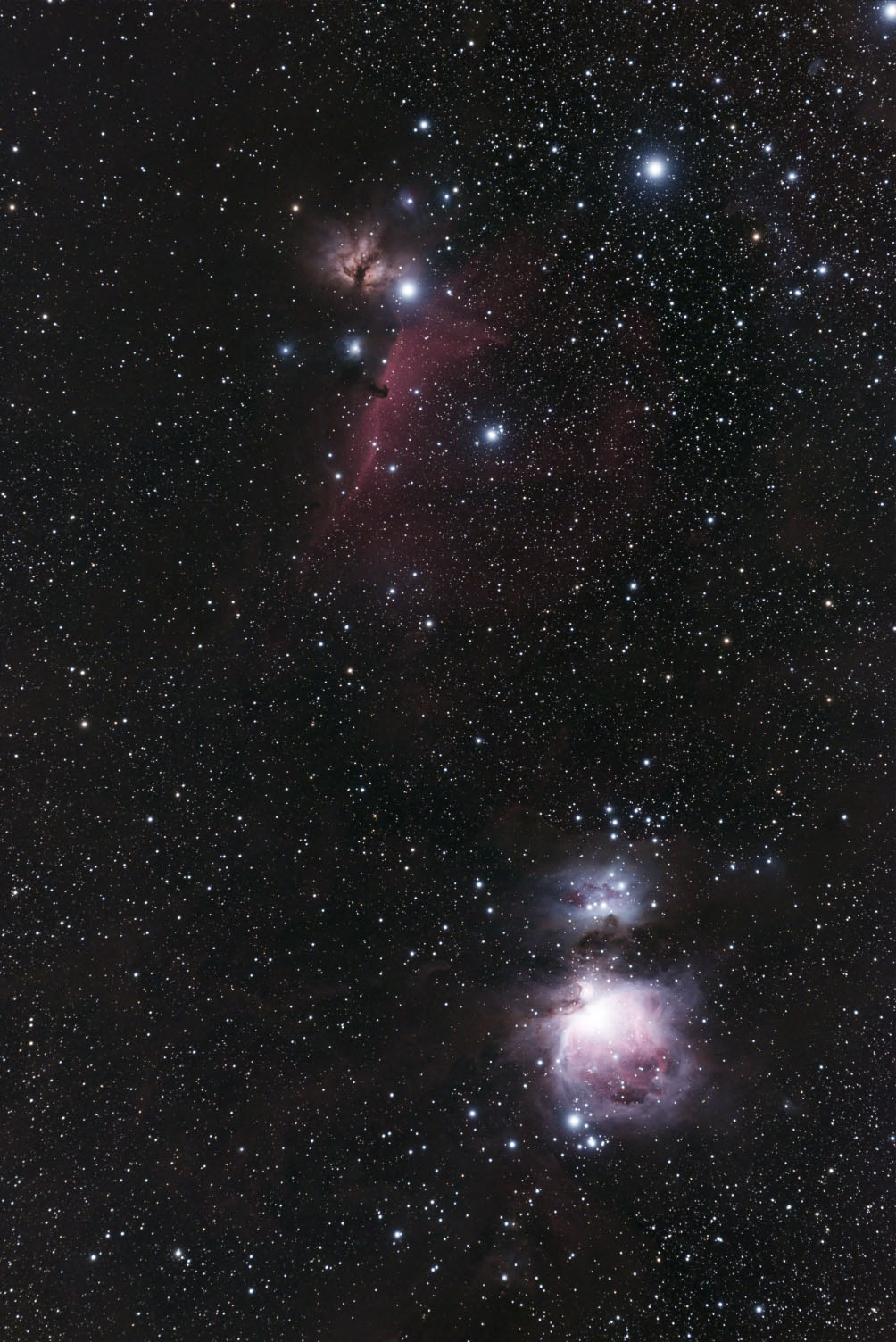
For those who know the sky, this star field needs no introduction.
It includes the Flame Nebula, Horsehead Nebula, and Orion Nebula complex.
Here's the Horsehead region, enlarged (from the same picture):

This is the last and possibly best of the pictures I took at Deerlick on November 13,
when unseasonably warm weather made it practical for me to photograph areas of the sky
that I don't normally see from a dark country site.
Stack of twenty 2-minute exposures, Askar 200-mm f/4 lens, Nikon D5500 (H-alpha).
Permanent link to this entry


|
2020
November
27
|
Pleiades and more
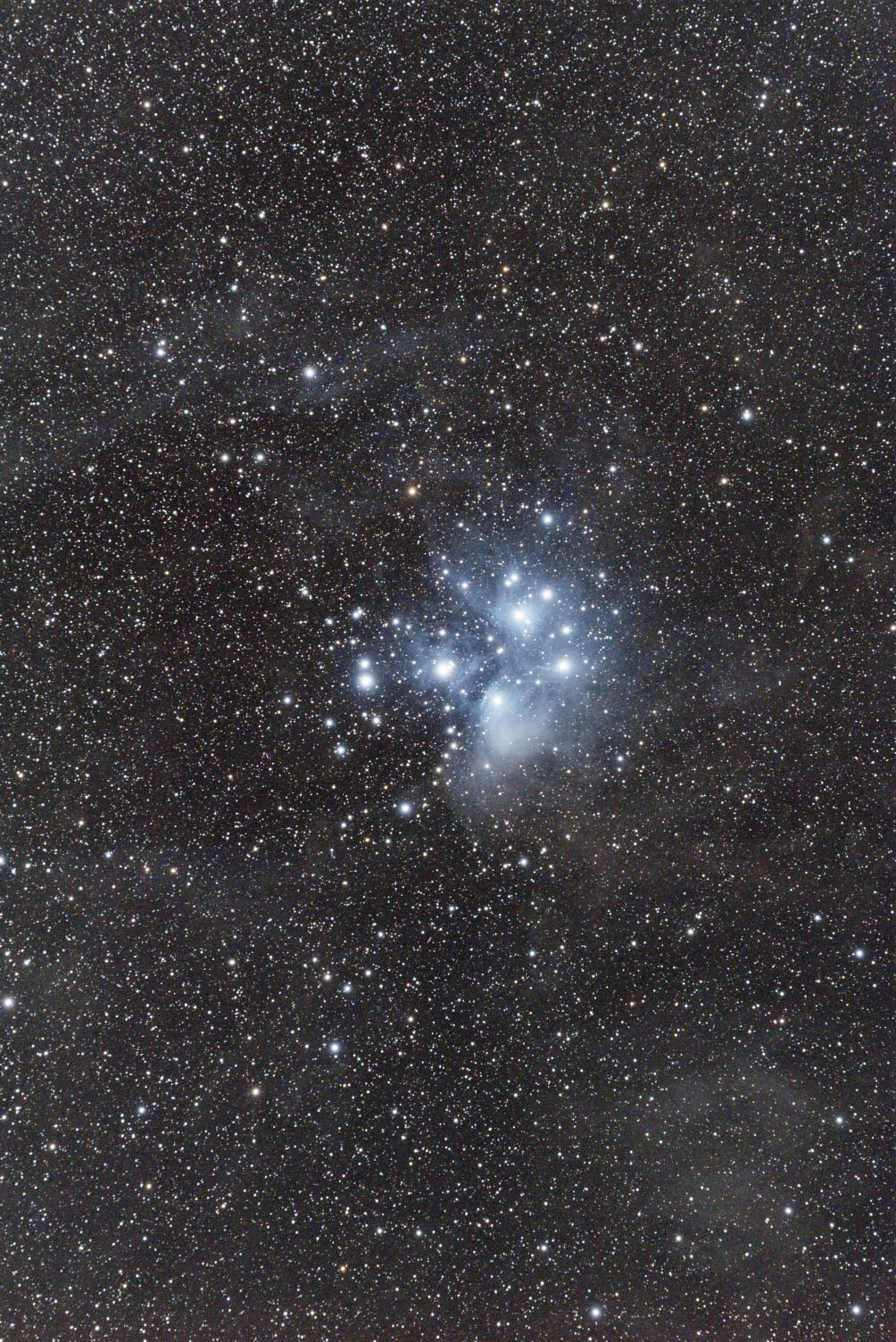
Here's another of the pictures I took at Deerlick on November 13.
This is the familiar Pleiades star cluster, a stack of sixteen 2-minute exposures
with a 200-mm f/4 lens and a Nikon D5500 (H-alpha modified) at ISO 400.
This star cluster is embedded in interstellar dust, which reflects the starlight.
Most good pictures of the Pleiades show some of the dust.
This picture shows a lot of it.
It also shows clouds of dust extending well away from the star cluster — look
at the wisps in the lower part of the picture.
These are surely illuminated, not by the stars in them, but by the reflected light
of other more distant stars and the galactic center.
That is, they are
integrated flux nebulosity.
How do I know this is dust, not gas? Because it photographs whitish-blue.
Ionized hydrogen would show up deep red or possibly deep blue.
Permanent link to this entry
Sunspots are back!

For the past couple of years, the sunspot cycle has been near minimum, and there have been
many days with no sunspots visible. Not any more. It looks like Cycle 25 is finally getting
off to a visible start. In fact, this large sunspot is visible with eclipse glasses (and no
telescope). It will be on the face of the sun for several more days, so have a look.
This is a single exposure with vintage equipment: Celestron 5 (1980), solar filter (just a few
years old), Canon 40D (2007). I took it today just before noon.
Permanent link to this entry


|
2020
November
26
|
Thanksgiving

Despite the COVID epidemic, we have much to be thankful for.
- Melody and Sharon are both gradually becoming healthier.
- We are approaching the end of a particularly agonizing and destructive period in American politics
(about which I could say a lot, but won't).
- I am working for a very successful, fast-growing business
and am reaping the benefits.
What we can't do is go see the grandchildren. Or go anywhere else unnecessarily.
Actually, the third wave of COVID is, so far, very tame in Georgia, although most other
parts of the country are hard-hit. But we are limiting our trips out of the house.
We did get pictures of the grandchildren, and here's one: Mary, doing one of her favorite things,
reading to her brothers and sisters. She is almost eight, which, we add, is half of Sweet Sixteen
and more than half as sweet.

I've settled into working at home much better than I expected to.
Yes, I miss the stimulation of seeing other people, but on the other hand, I have a lot of
work to do and a lot of people to communicate with.
In fact, right now, my main wish is for video conferences to become less numerous.
My work is done between them, not during them!
This is perhaps the first year ever when my work obligations did not diminish during the
holiday season. As a student, I dreaded the month-long shutdown of UGA every December
(and another month-long shutdown every August). When I was a full-time UGA employee, there was
still a real drop in activity when the students left for vacation. But FormFree doesn't slow down.
Business is booming. We get two days off for Thanksgiving and two for Christmas. Actually, as a
contractor, I can work any time I want to, and I don't get paid days off at all.
But I can at least rest when other people aren't needing me.
Today, the day began oddly with a heavy thunderstorm at 5:25 a.m. (in November, with an outside
air temperature of 65 F). I actually got up to check weather radar, then went back to bed.
It's just Melody, Sharon, and me — we're not going to see any relatives — but
that's OK. Sharon and I have colds, and just in case, we don't want to spread them around.
One interesting cultural detail: A significant number of people are expressing relief that they
don't have to do competitive cooking and homemaking, difficult travel, etc., nor deal with
difficult relatives (who, this year, would probably be arguing politics). We always enjoy our
family gatherings, but even so, we get a sense of increased independence from being alone this time,
getting some rest, and getting to be ourselves.
Permanent link to this entry


|
2020
November
23
|
The Elephant Trunk Nebula (Mu Cephei Nebula, IC 1396)
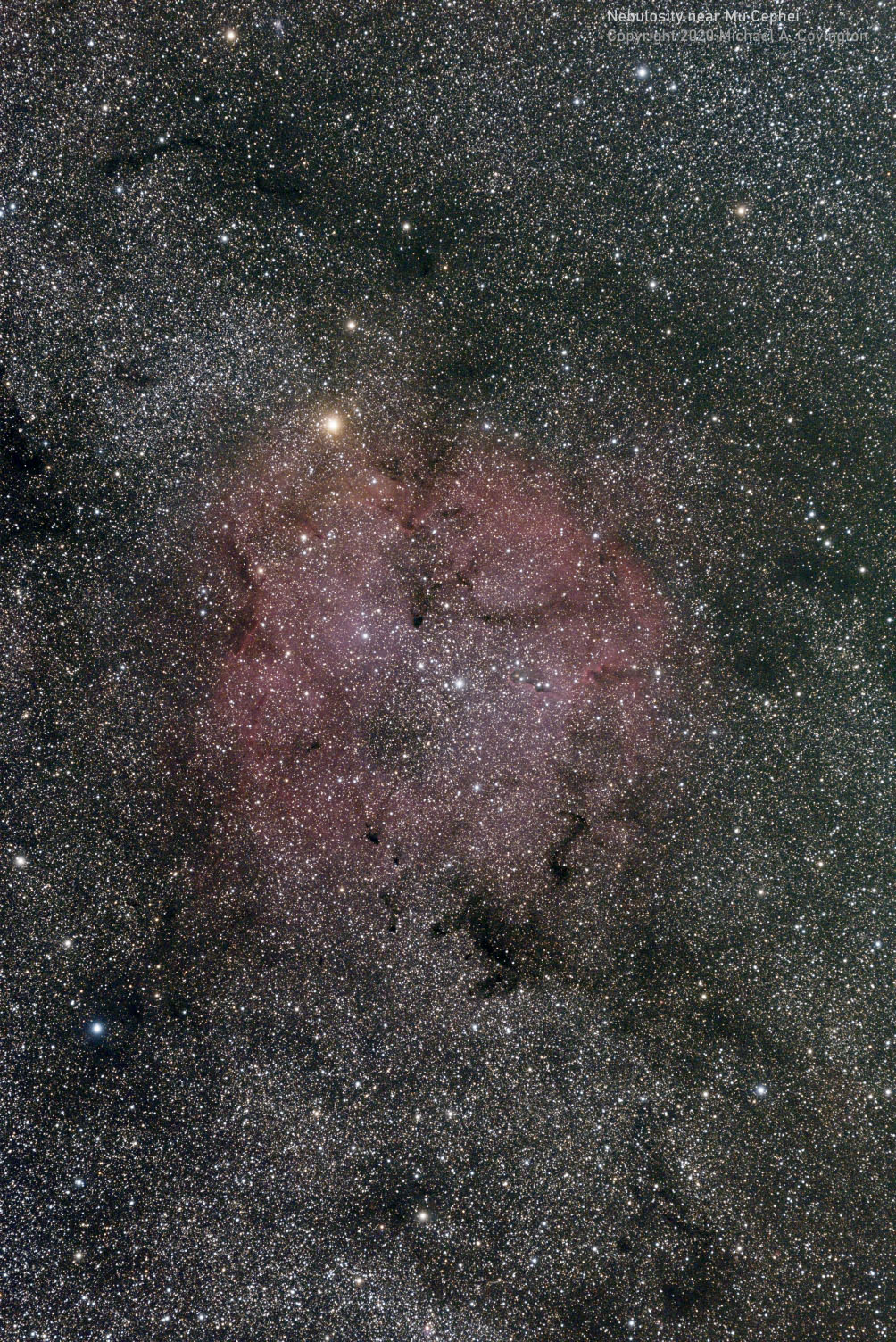
This is another picture from the evening of November 13 at Deerlick Astronomy Village.
What you see is often called the Elephant Trunk Nebula because
a streak running to the right, from near the bright central star
to the edge,
supposedly resembles an elephant's trunk.
(In this generously exposed picture, it is not very dark, and other streaks are
much darker. Look for a star that seems to have a hook encircling it.)
The red part of the nebula is ionized hydrogen, an active star-forming region; the denser parts are dark.
The bright orange star at the top is Mu Cephei, Herschel's "garnet star."
This is a stack of sixteen 2-minute exposures with a Nikon D5500 (H-alpha modified)
at ISO 400, an Askar 200-mm f/4 lens wide open, and an AVX mount with periodic-error
correction, polar-aligned with an iOptron iPolar camera.
For one of my earlier photographs of this same object,
click here.
Permanent link to this entry
The Flaming Star Nebula
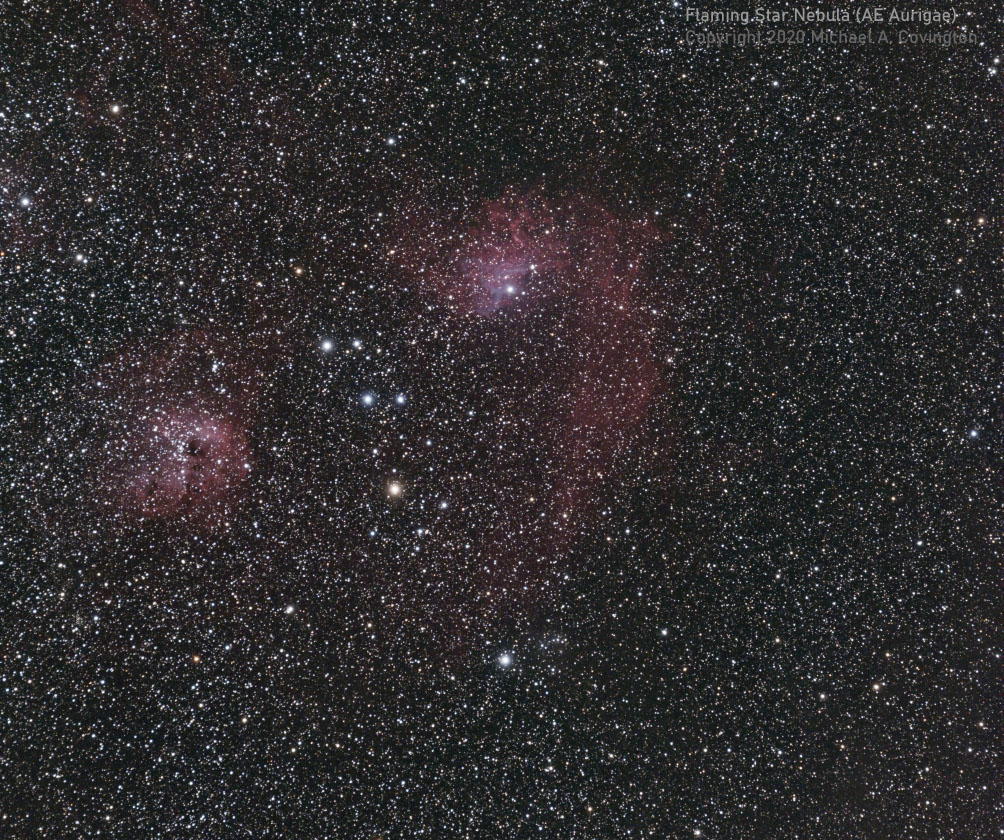
Here's another catch from Deerlick. The nebula with the bright star in it is IC 405,
a cloud of gas through which the star AE Aurigae happens to be passing.
That star apparently was formed in the Orion Nebula two million years ago,
and a collision between groups of stars sent it speeding away, so now it's in the
constellation Auriga. The nebula to the left is IC 410, and in between them is
the star cluster Melotte 31, consisting mostly of five bright stars that have been
nicknamed the Flying Minnow. Stack of eighteen 2-minute exposures, same equipment
as above. In January 2019 I got a striking picture of this area from home;
click here
to see it.
Permanent link to this entry


|
2020
November
21
|
Mars retreats
Mars is now perceptibly farther from the earth than a few weeks ago, but still closer
than usual, and I'm still getting presentable pictures of it. These two were not given
the same digital processing or even the same amount of enlargement, so don't expect
them to look alike. Taken 48 hours apart, they show you the same side of Mars, because
Mars' rotation period, like Earth's, is about 24 hours. Each is a stack of the best
20% of about 10,000 video images captured with a Celestron 8 EdgeHD, 3× focal
extender, and ASI120MC-S camera.
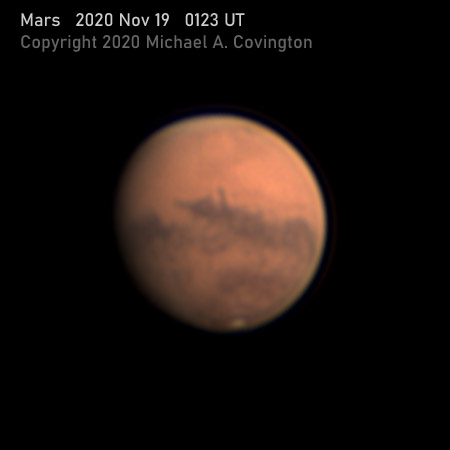
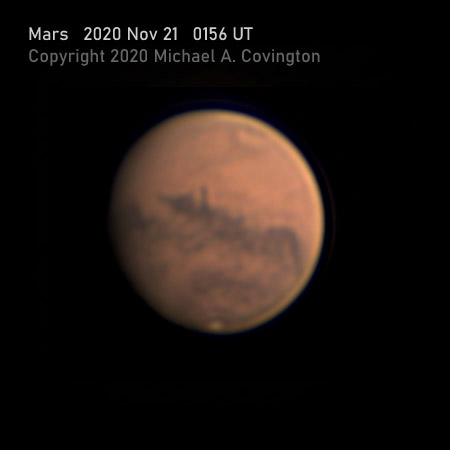
I have more pictures from Deerlick and will post them soon.
Also, for those of you who have been wondering about my iOptron GEM45 mount,
I've been sorting out a mechanical problem with it, and it's not fully fit for duty
right now, although the second Mars picture was taken with it.
Permanent link to this entry


|
2020
November
17
|
Orion with a visitor
There are plenty of Deerlick pictures yet to be revealed, but right now I want to
show you a picture I took last night from my driveway.
What do you see in this picture of Orion that normally isn't there?
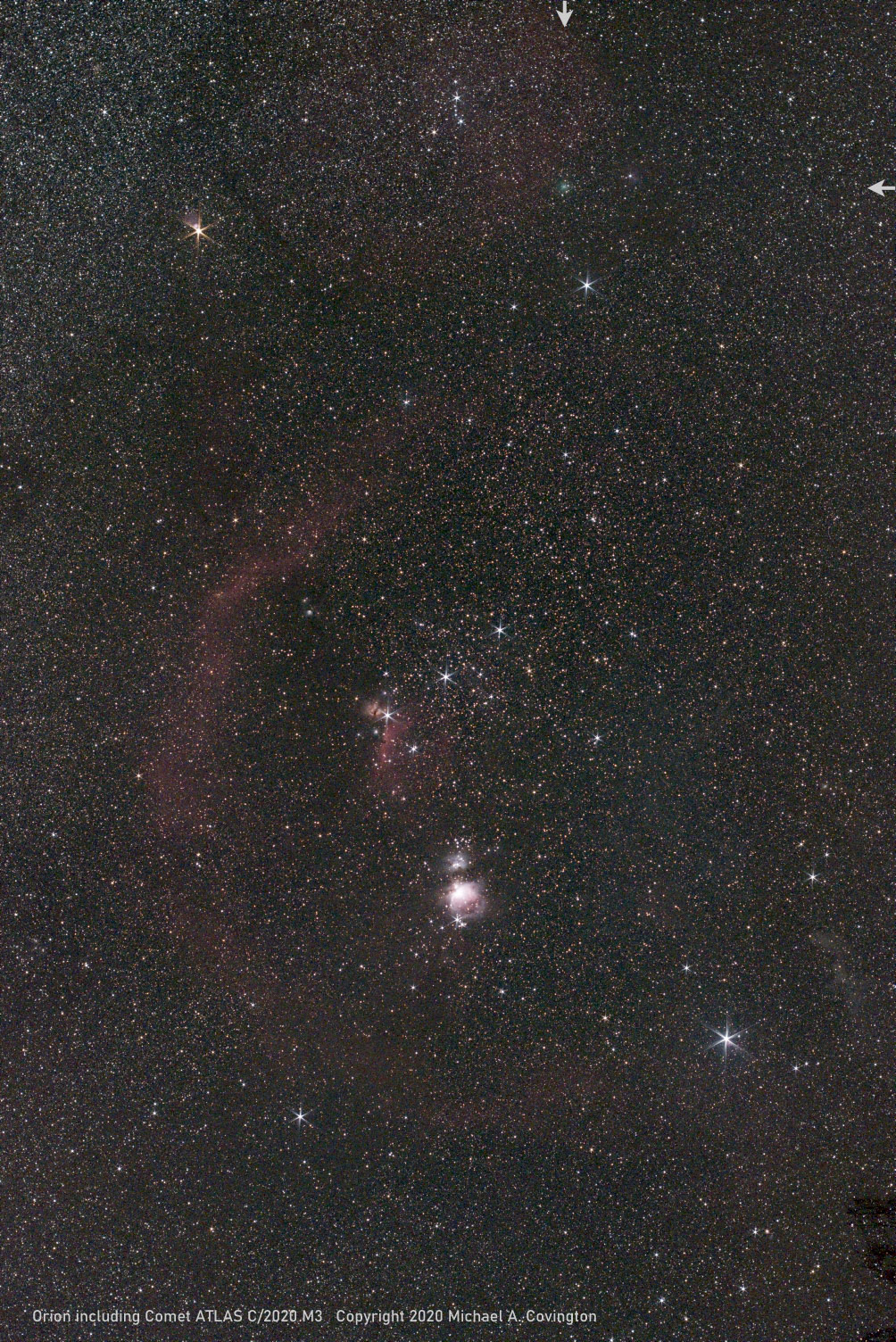
The two arrows on the top and right edges point to it. It looks like a star cluster
with nebulosity. Actually, the stars were there all along, but the fuzzy object
seemingly nestled among them is Comet ATLAS (C/2020 M3).
Of course, the usual scenery of Orion is all there too, from the bright Orion Nebula
to many fainter nebulae.
Stack of six 2-minute exposures taken in Athens, Georgia, with a Nikon D5500 camera
(H-alpha-modified) and vintage-1970 Nikkor 50-mm f/2 lens at f/4 on my AVX mount.
Permanent link to this entry


|
2020
November
16
|
Eastern Veil Nebula (NGC 6992)
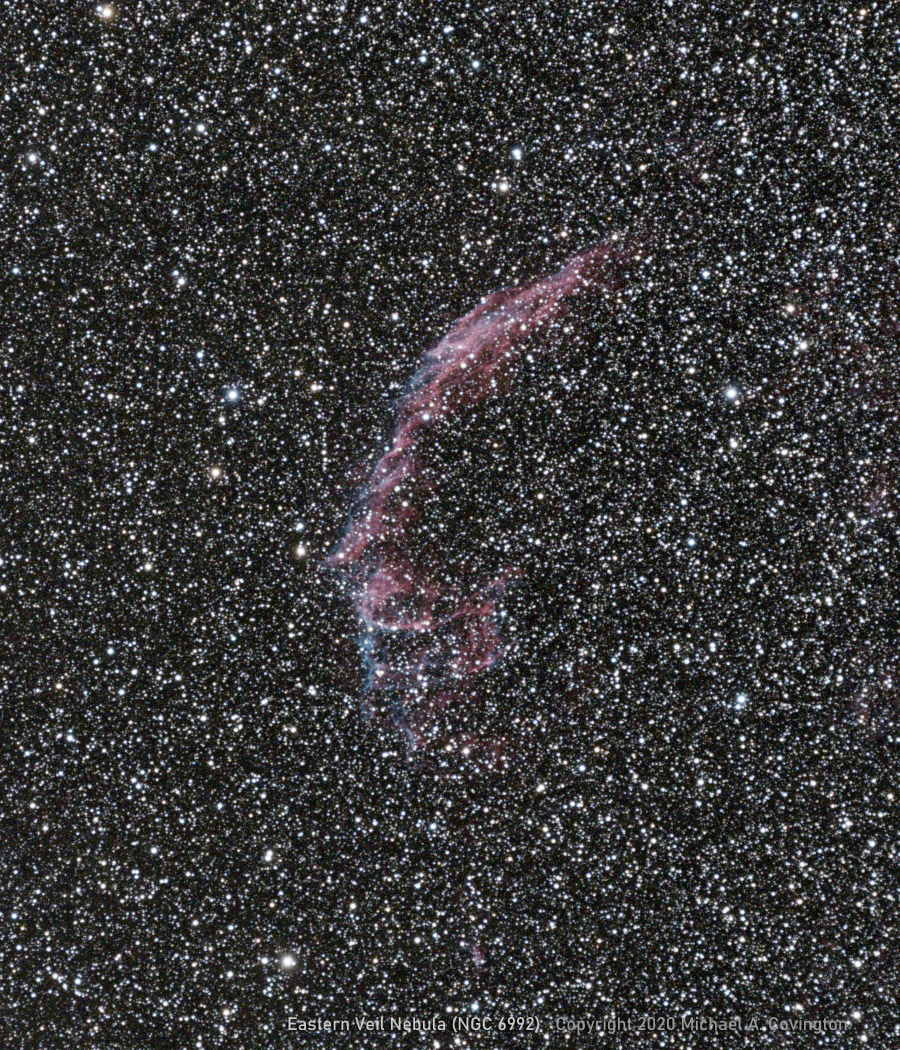
This is the eastern half of the round cloud of gas expelled by an ancient supernova.
It's in the constellation Cygnus and can be seen faintly with a telescope or even
with binoculars. Because of its very high temperature, it photographs as a mix of
blue and red areas, not just the usual red of ionized hydrogen.
On Friday evening, November 13, we had unexpectedly warm and clear weather, and
amateur astronomers converged on Deerlick. At this time of year it's completely dark
at 7 p.m., so I had a six-hour observing session and finally headed home at 1 a.m.
This is the first of the pictures I took that evening.
It is a stack of sixteen 2-minute exposures with an Askar 200-mm f/4 lens wide open,
Nikon D5500 (H-alpha modified), and Celestron AVX mount (PEC-trained), polar-aligned
with an iOptron iPolar camera.
This is the central part of the picture, cropped and enlarged.
Permanent link to this entry
North America Nebula
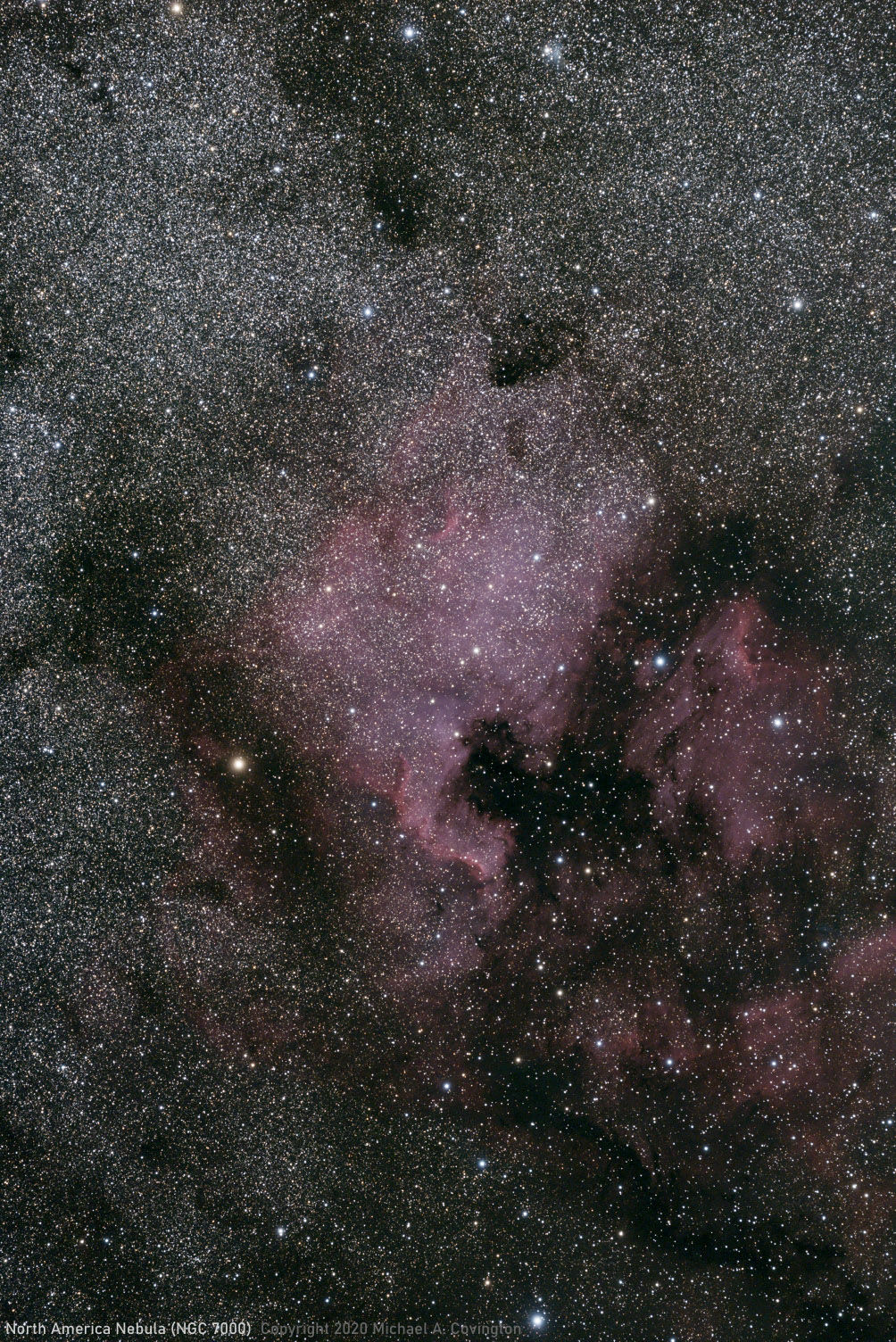
I've photographed the North America Nebula many times, but this may be the best picture
yet. Same equipment and location as the picture above; stack of twenty 2-minute exposures.
This is the whole picture, edge to edge, with no cropping.
Permanent link to this entry


|
2020
November
11
|
I still don't know everything. Do you?
Another Facebook posting that was well received in this turbulent time:
I must be the only person left who doesn't know everything.
Everybody else has some magical ability that enables them to see The Truth about any question that comes up,
and immediately start haranguing all their friends, demanding that they see it the same way.
Will the Pfizer vaccine work? Was the election thrown by fraud? I don't know!
Prior experience leads me to estimate that the answers are "Probably" and "Very unlikely."
But those are just educated guesses.
I can't see the vote-counters in Pennsylvania or the viruses in the Pfizer labs from here. Neither can you.
These are questions that need to be decided by evidence,
and I'm not the one who has the evidence. Let's see what comes out.
It doesn't do any good to sit around imagining the answers.
And that's the problem.
Too many people live in an imaginary world, where controversies are decided by
sitting around and making something up, then shouting it from the rooftops.
I can imagine all sorts of things.
But I don't claim to know anything until I have good evidence for it.
And I'm not going to grab one piece of evidence and close my mind to the rest.
You've all seen journalists who do that. You can read that kind of reporting all day long.
I'm especially wary of sources that tell me to ignore all the other sources.
("Ya gotta watch this video...") That's how you end up deceived.
It's tiresome the way so many people take sides strongly based on pure guesswork,
and then demand that all their friends take the same side. It's foolish.
Permanent link to this entry


|
2020
November
10
|
"Do your research"
Another recent posting of mine on Facebook (with some follow-up comments
incorporated into the text). This one got over 100 "likes" in 24 hours.
[As of a week later, over 50 people had shared it!]
"Do your research," people say. No.
I don't have time to spend hours researching everything everybody throws at me.
And I am not fully qualified to do research in all fields.
Instead, I look to the experts.
If it's a medical theory, I'll ask doctors and medical researchers.
If it's about the history of the Bible, I'll ask biblical scholars. And so forth.
Some of you may not realize that I've spent my whole career doing research.
I know how to find out what other researchers think of each other's work,
whether the journals they publish in have reliable review processes, and so forth.
Google is no substitute for real research skill.
And you have to look at the community of knowledgeable people,
and the variety of opinions within it, not just hunt for one
or two who say what you want them to say.
If you have a theory to promote, you should be spending your time
getting feedback from real experts, not spreading it among non-experts
who can't really tell whether it's mistaken.
What matters is not whether a claim convinces you or me,
it's whether it convinces someone who really knows about the subject.
A very common tactic of cranks and conspiracy theorists is to say, "Do your research,"
as if it were our job to evaluate their claims,
and as if their claims had to be true as long as we haven't disproven them.
No... That is not how truth works.
Random words aren't true just because nobody has disproven them yet.
The person making a claim needs to justify it,
show that knowledgeable people consider it credible, and respond to criticism.
Not the other way around.
Am I obligated to do hours of research every time somebody anywhere in the world claims
to have seen a UFO? No. Do I have to "admit" the UFO is real if I haven't spent time
disproving it? No, no, no. The same goes for other unusual claims.
Permanent link to this entry


|
2020
November
9
|
An open letter to my Facebook friends
(Posted on Facebook this morning...)
OLD FRIENDS — If you are leaving Facebook, please join LinkedIn (the business connection site, free of charge)
and send me a connection request so I can stay in touch with you.
Also, consider keeping your Facebook account open and just not using it as much.
The word today seems to be that if you're politically conservative, you're supposed to leave Facebook and go
— where? I'm not sure.
If my Facebook community breaks up, I'll be sad. The best thing about Facebook has been
reconnecting with people I haven't seen in decades. I'm a shy person, and I
really like being able to see what people are up to without having to demand their attention myself.
Can you imagine how many letters I'd have to write if I were keeping in touch with everybody the old way?
It just wouldn't happen, and people would be lost forever.
The worst thing about Facebook has been the cranks, quacks, memes, fake news, and propaganda.
I know Facebook may have made some controversial decisions trying to control this,
but they're a private business. They are not obligated to publish everything that everybody says.
I've understood that from the start.
I do think Facebook should have competition.
It will be a bit inconvenient having to check three or four media instead of just one
to stay in touch with all of my friends.
But if Facebook had had competition, it would have learned a lot faster how to do its job well.
It will be really bad if the competing social media are labeled by politics, religion, or values.
Then I'll only be able to talk to people just like myself and never the ones who are different.
That will take away much of social media's value.
Worse, everybody will be in an echo chamber, and unreasonable claims will never be challenged.
One last thought.
Before you leave Facebook, ask yourself if you're just afraid of being challenged,
and also whether you've believed allegations of "censorship" that go beyond the truth.
Don't go to a place where you will be less well-informed than you are now,
and less able to influence others.
You may be leaving just when you're most needed.
Permanent link to this entry


|
2020
November
8
|
45 years
Today I thank Melody for 45 years of friendship and at least 44 years of love.
We met on November 8, 1975 (story here)
and today we were able to revisit the spot where it happened.
We had to do it quickly and wear masks because of the pandemic.
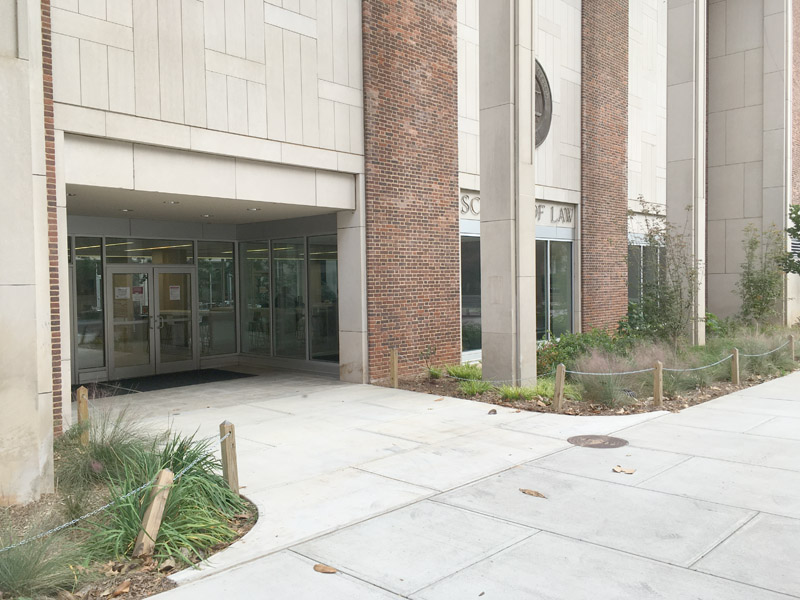
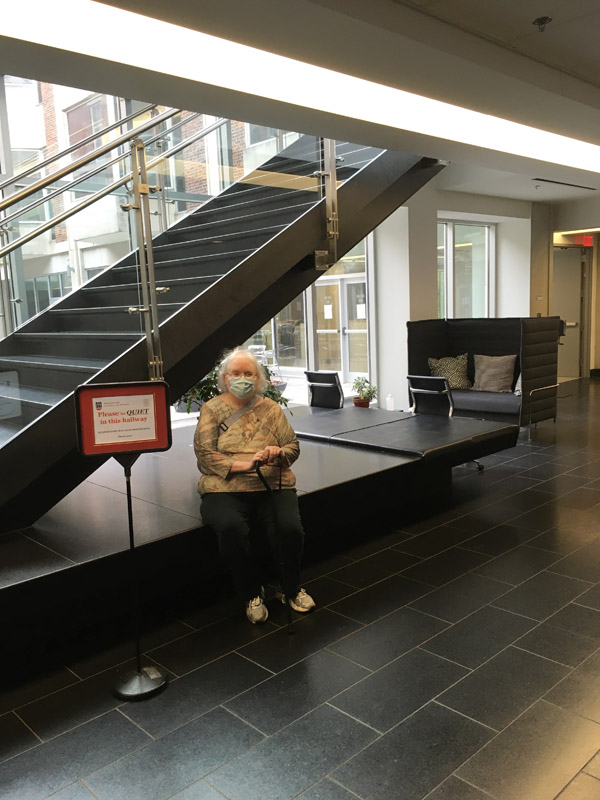

I was helping the University host a recruiting event in what was then the Law Auditorium
(now divided into Classroom A and a couple of others) in an area of the UGA Law School
now known as the G. Sanders Griffith III Concourse, though then it was just a lobby, and
part of it was an open breezeway. The Law School wasn't involved, except that it was in
their building.
When I first saw Melody, she was standing near the stairs, slightly farther away than
where she is sitting in the picture — roughly where there is now a table, as best
I can remember.
It was friendship at first sight; real devotion to each other came a few months later,
although our friends probably realized how inseparable we were going to be before we did.
Gratias Deo.
Permanent link to this entry


|
2020
November
7
|
The floor of Mare Orientale
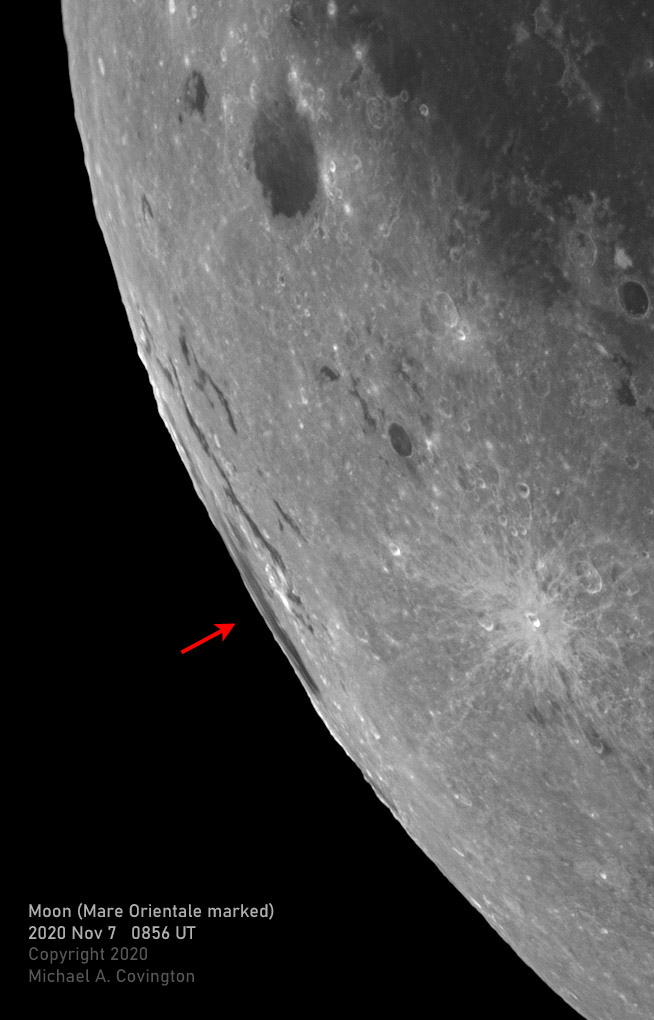
In the picture above you see the dark floor of Mare Orientale,
not just the mountains that encircle it, which I've photographed many times before.
Mare Orientale
is
a spectacular dark plain on the moon that is encircled by two mountain ranges.
This is a challenge because we usually can't see Mare Orientale.
It is right on the edge of the visible face of the moon, and the moon always keeps
the same side turned toward earth.
Well, almost. Because the moon's orbit is not a perfect circle,
its visible face seems to wobble, and we do get to peek
past the edge just a little, some of the time.
The wobble is called libration.
A while back I found out from
this
discussion on Cloudy Nights
that the libration for seeing Mare Orientale would be particularly favorable
for a few days around November 8.
For Mare Orientale to be visible, the moon has to be full or past full (waning,
not waxing), meaning it isn't in the evening sky, and
we get our best view of it after midnight.
Libration in longitude needs to be -5° or more,
and it helps if libration in latitude is also negative.
The weather forecast was unfavorable, but I decided to try early this morning (Nov. 7).
Last night I got out my 1980-vintage Celestron 5 and took the infrared images of
Jupiter that I blogged then. I left the telescope set up, but as soon as the moon
had risen high enough (around 1:30), the sky clouded over, with solid overcast that
curiously did not show up on weather radar. I kept checking, and after numerous
abortive attempts to photograph the moon through thin clouds (which can be done),
I was rewarded with a big hole in the clouds around 4 a.m.
The picture above is a monochrome image in infrared light (chosen because the air is
steadier in infrared than at visible wavelengths) through my Celestron 5 (12.5-cm f/10)
with an ASI120MM-S camera and IR-pass filter. It is a stack of the best 50% of
2014 video frames, digitally sharpened and cropped.
Now what are we looking at? Here is a Virtual Moon Atlas map that should match
my picture:
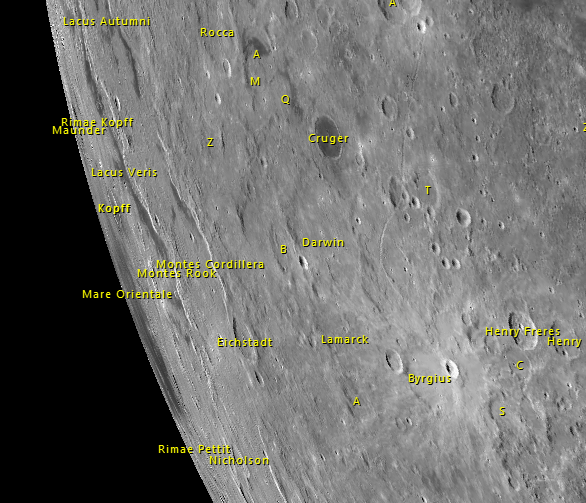
And here's how Mare Orientale looks to a Lunar Orbiter flying over it.
Now you see why it is so extraordinary.
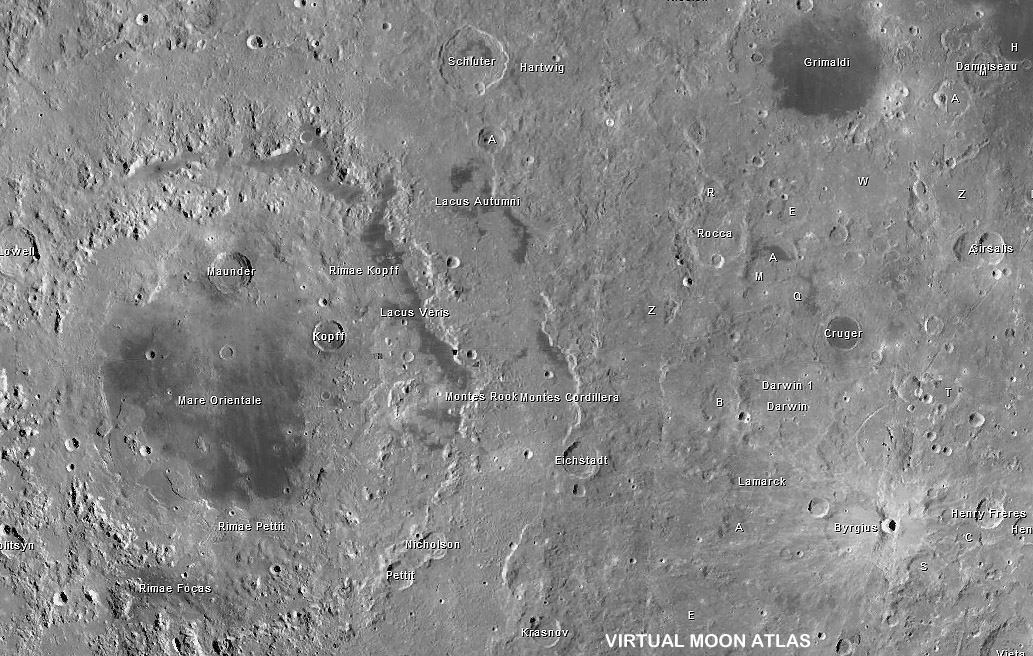
Permanent link to this entry


|
2020
November
6
|
Mars again
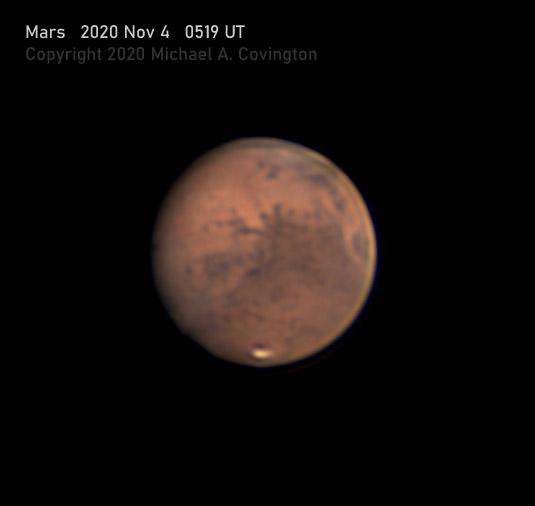
One more Mars picture, on the evening of November 3 (Nov. 4 UT).
8-inch telescope (C8 EdgeHD, 3x extender, ASI120MC-S camera),
stack of the best 50% of about 7500 video frames.
Below is a map generated by WinJUPOS software. Note that one of the streaks you can see,
the dark area straggling leftward in the upper left quadrant,
is the huge canyon system Valles Marineris.
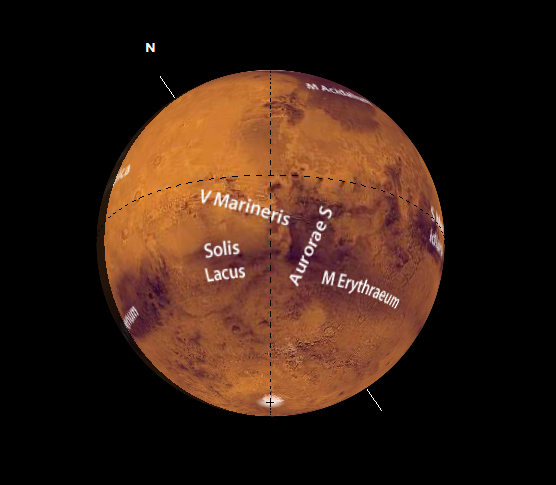
Permanent link to this entry
Jupiter in infrared
Earlier this evening (Nov. 6), I set up my 5-inch telescope
(Celestron 5) for some lunar work to be done after midnight.
To try things out, I took two pictures of Jupiter, one with a 3x teleconverter
and one without. These are in infrared light (using an IR-pass filter)
with a monochrome ASI120MM-S camera. They are stacks of the best 50%
of, respectively, about 3600 and about 3000 video frames.
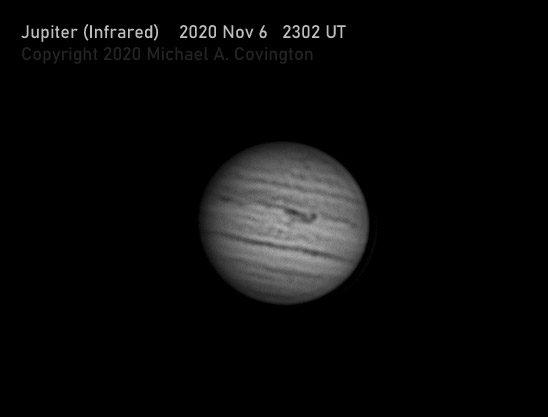

Permanent link to this entry


|
2020
November
2
|
Centennial of AM radio
Today (to be precise, November 2, 2020, at 6 p.m. EST) marked 100 years since
the beginning of commercial radio broadcasting in the United States,
at station KDKA (Pittsburgh), which is still in business.
KDKA is a wide-area clear-channel station. Fifty years ago, that was important.
People in remote areas might not have local radio stations, but at night they
could pick up wide-area stations all over the country. That's how so much of
the South listened to WSM's Grand Ole Opry, for example. Sound quality wasn't
perfect, and there was often some crackling noise, but it was still a lot better
than not hearing anything at all.
Today you can still listen to clear-channel stations,
but there's less need for it, and also a lot more
interference to add noise to the signal. Most digital circuits interfere with
an AM radio, for instance. My Tascam audio recorder does.
The best reception is likely to be with your car radio, outside of town;
the antenna is outside the metal body of the car, which shields it from
the engine and electronic devices inside the car.
KDKA does not serve the Southeast, but I was able to listen to it for a
few minutes about 1 hour after the exact 100-year mark. It was fading in and out,
and later a Spanish-speaking station on the same frequency was all I could get.
But click here
to hear a few seconds of KDKA on the centennial day.
I made the recording using a small transistor radio, in a place in my house
chosen to be several feet away from other electronic equipment.
Because of interference, I couldn't connect the Tascam to the radio, or even hold
it within two feet of it. Instead, I held it about a yard away from the radio,
using speaker and microphone. Primitive, but it worked.
Permanent link to this entry
Mars in infrared and RGB
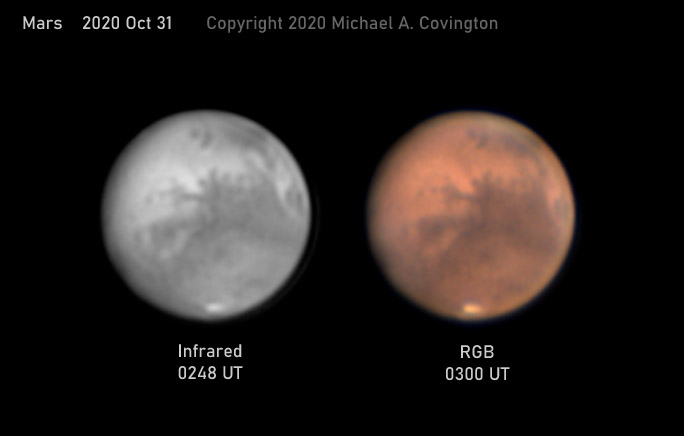
Mars, with the same equipment and techniques I've been using regularly — 8-inch
telescope, 3× focal extender, and video camera — except that this time I also
took an infrared picture, using an ASI120MM-S camera with an IR-pass filter.
The air is steadier for infrared light than for visible light, so I want to continue
doing this. Each picture is a stack of the best 33% of about six thousand video frames.
Permanent link to this entry


|
|
|
This is a private web page,
not hosted or sponsored by the University of Georgia.
Copyright 2020 Michael A. Covington.
Caching by search engines is permitted.
To go to the latest entry every day, bookmark
http://www.covingtoninnovations.com/michael/blog/Default.asp
and if you get the previous month, tell your browser to refresh.
Portrait at top of page by Sharon Covington.
This web site has never collected personal information
and is not affected by GDPR.
Google Ads may use cookies to manage the rotation of ads,
but those cookies are not made available to Covington Innovations.
No personal information is collected or stored by Covington Innovations, and never has been.
This web site is based and served entirely in the United States.
In compliance with U.S. FTC guidelines,
I am glad to point out that unless explicitly
indicated, I do not receive substantial payments, free merchandise, or other remuneration
for reviewing or mentioning products on this web site.
Any remuneration valued at more than about $10 will always be mentioned here,
and in any case my writing about products and dealers is always truthful.
Reviewed
products are usually things I purchased for my own use, or occasionally items
lent to me briefly by manufacturers and described as such.
I am no longer an Amazon Associate, and links to Amazon
no longer pay me a commission for purchases,
even if they still have my code in them.
|
|




























